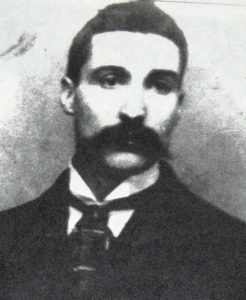
I have wanted to know the cause of my great grand uncle James O’Rourke’s death and to find out why he only lived to his mid-30s. I went online to General Register Office in Northern Ireland and did a search for James’ death certificate. I was unable to read the horrible handwriting on it, so I ordered a copy to be mailed to my home. Yesterday, after at least two weeks waiting, I received it in my mailbox. James died April 20, 1902 in the Kilkeel Workhouse. James’ cause of death as phthisis (a word I had to look up) or in other words, tuberculosis.
When I think about what happened to him, I’m deeply saddened. James died at the age of 36 in 1902 in Kilkeel, Ireland. He was in the prime of his life. He was married and had a young child — Mary Catherine O’Rourke. James also had a job in Liverpool, maybe not a very desirable job, but he was earning money and supporting his family. The family frequently came back to his home in Ireland to visit.
We know little about James’ life before he died. What we do know is this: He was born in Ballintur near Killowen in what is now Northern Ireland in 1864. His parents were James O’Rourke and Mary Hughes O’Rourke and he was the couple’s third child. Tragically their second child, Francis, died in infancy from cholera. James was named after his father and had three brothers growing up: my great grandfather John, who was older than he, and two younger brothers, Thomas and Francis.
James at some point — probably in the early 1890s — left Ireland for Liverpool because there was little work in Ireland outside of farming during the late 19th century and early 20th century. James married Rose Rogers, the sister of his elder brother’s wife. He worked on the docks in Liverpool as a coal porter, probably loading and unloading coal on the many ships that docked in England’s busiest port. James and Rose had two children, both girls, though one, Annie Josephine Ivy, died tragically when she was eleven months old in 1901.
The affects of tuberculosis
Today, those who work in education might have to get a “TB” tuberculosis test. Other than that, no one really thinks about the disease anymore because antibiotics pretty much takes care of it. But before the discovery of antibiotics, in the 19th and early 20th centuries it was a devastating disease. Tuberculosis caused more deaths than any other disease in the 19th century. By the late 19th century, 70 to 90% of the urban populations of Europe and North America were infected with tuberculosis, and about 80% of those individuals who developed active tuberculosis died of it.1
Tuberculosis was one of the most feared diseases in the world at that time and highly contagious. The disease affected the urban poor mostly because it thrived where conditions were crowded with poor sanitation. 2 James lived in Liverpool and worked on the docks where conditions were ripe for the spread of turberculosis bacillus.
After James came down with the disease, he probably knew he was going to die because most people did. The death certificate says he was ill for four months. If he was a typical tuberculosis victim, he would have suffered from fatigue, night sweats and a general “wasting away.”3
The Kilkeel Workhouse

James and his family returned to Ireland after he became sick. Generally, tuberculosis victims were isolated and James was no different as he ended up hospitalized in the Kilkeel Workhouse. Interestingly, the Kilkeel Workhouse was originally built to house the poor and destitute (Poor House) of the Newry-Mourne area in 1840.4 Later, during the famine, a fever hospital was added to the site, where James eventually died. That hospital still stands today.
I feel sad for James that he suffered with this terrible affliction for four months. Also, I feel sad for Rose who lost her husband just one year after losing a child. Especially I feel sad for Mary Catherine, who lost her father at the young age of three. I, too, lost a father at a young age (five). If Mary Catherine’s experience was anything like mine, she probably didn’t comprehend her father’s death and loss until many years later.
- “Tuberculosis in Europe and North America, 1800–1922.” Open Collections Program: Contagion, Tuberculosis in Europe and North America, 1800–1922. N.p., n.d. Web. 23 May 2017. <http://ocp.hul.harvard.edu/contagion/tuberculosis.html>.
- “Early Research and Treatment of Tuberculosis in the 19th Century.” American Lung Association Crusade. N.p., n.d. Web. 23 May 2017. <http://exhibits.hsl.virginia.edu/alav/tuberculosis/>.
- “Early Research and Treatment of Tuberculosis in the 19th Century.” American Lung Association Crusade. N.p., n.d. Web. 23 May 2017. <http://exhibits.hsl.virginia.edu/alav/tuberculosis/>.
- Higginbotham, Peter. “Kilkeel, Co. Down.” The Workhouse in Kilkeel, Co. Down. N.p., n.d. Web. 23 May 2017. <http://www.workhouses.org.uk/Kilkeel/>.

How very, very sad, indeed, Lois. My heart aches for both Rose and her daughter, Mary Catherine. How very strong and resilient was Rose…She experienced such loss in her life-as a child, a young mother and young wife!
Thank you, once again, Lois, for researching, writing and sharing this story.
PS: How very handsome was James!
I agree. He was very handsome.
Great bit of history.
Cassie, I never knew how bad tuberculosis was before the discovery of antibiotics. I learned something writing this post.